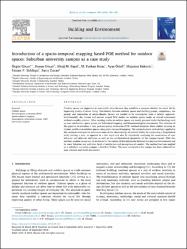Introduction of a spatio-temporal mapping based POE method for outdoor spaces: Suburban university campus as a case study

View/
Access
info:eu-repo/semantics/openAccessDate
2018Author
Gocer, OzgurGocer, Kenan
Basol, Altug M.
Kirac, M. Furkan
Ozbil, Ayse
Bakovic, Mujesira
Siddiqui, Faizan P.
Ozcan, Baris
Metadata
Show full item recordAbstract
Outdoor spaces are important to sustainable cities because they establish a common identity for social life by improving quality of urban living. The relation between outdoor spaces and building groups, competency, use period, and interaction of micro-climatic factors are needed to be investigated from a holistic approach. Unfortunately, the limited and narrow scoped POE studies on outdoor spaces make an overall assessment without causality relation. Other existing studies in outdoor spaces are mostly grouped under the headings such as; user satisfaction, space syntax and behavioral mapping, and biometeorological assessments. The intention of this paper is to introduce a new post-occupancy evaluation (POE) method integrates these studies focusing on various problems in outdoor spaces using spatio-temporal mapping. The comprehensive methodology applied in this research attempted to overcome some of the shortcomings of related studies by conducting a longitudinal study (during a year, as opposed to a few days) and also by objectively analyzing the associations of user behavior and physical attributes as well as the configurational properties of the campus layout. With this method, outdoor spaces can be evaluated in the context of the interaction between the physical environment and its users' behavior and activities, level of satisfaction and perceptions of comfort. The method has been applied on a suburban university campus in Istanbul, Turkey. The main courtyard of the campus has been subjected for map creation and result discussions.

















